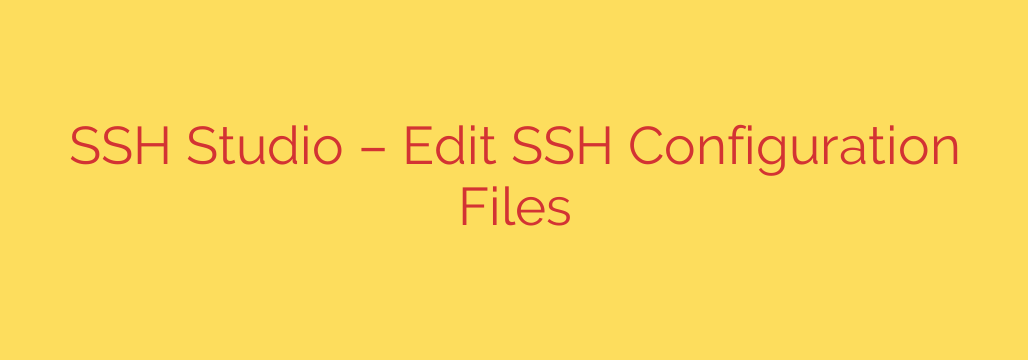
Master Your SSH Config: A Guide to Simplified Server Management
For any developer, system administrator, or DevOps professional, the SSH configuration file (~/.ssh/config) is a cornerstone of daily workflow. It starts simply enough—a single host alias to save you from typing a long IP address. But as your responsibilities grow, so does that file. Soon, it becomes a sprawling text document filled with dozens of hosts, different user accounts, custom ports, and complex proxy commands. Managing this file manually is not just tedious; it’s a recipe for errors and security vulnerabilities.
A single typo can break a critical connection, and a disorganized file makes finding the right server a frustrating exercise in grep and guesswork. It’s time to move beyond the limitations of the plain text editor and adopt a more modern, efficient, and secure approach to managing your SSH connections.
The Hidden Dangers of Manual SSH Configuration
Relying on a text editor to manage a complex SSH config file introduces several significant risks that can hinder productivity and compromise security.
- Costly Syntax Errors: The SSH config file has a specific syntax. A misplaced keyword, an incorrect indentation, or a simple typo can render an entire host entry unusable. Troubleshooting these subtle errors wastes valuable time and can be incredibly frustrating, especially under pressure.
- Disorganization and Confusion: Without a structured system, your config file can quickly become a “junk drawer” of server entries. Distinguishing between production, staging, and development environments or remembering which identity file belongs to which client becomes a challenge. This lack of clarity increases the risk of connecting to the wrong machine with the wrong credentials.
- Security Oversights: Manually managing dozens of entries makes it difficult to enforce consistent security policies. It’s easy to forget to specify the correct
IdentityFilefor a host, accidentally reuse keys across different security domains, or leave outdated, insecure configurations active.
Streamline Your Workflow with a Visual SSH Editor
The solution to this complexity is to use a dedicated SSH configuration manager. These tools provide a graphical user interface (GUI) that acts as an intelligent front-end for your ~/.ssh/config file. Instead of manually typing out parameters, you work with intuitive forms, dropdown menus, and organized lists, while the tool handles the syntax perfectly behind the scenes.
This approach fundamentally transforms how you interact with your SSH connections, turning a chaotic text file into a structured, searchable, and secure database of your remote hosts.
Key Features of an Effective SSH Configuration Manager
When evaluating a tool to manage your SSH connections, there are several essential features to look for that provide maximum benefit.
Intuitive Host and Group Management
The ability to organize servers is paramount. A quality manager allows you to group hosts logically—for example, by project, client, or environment (e.g., “Production-Web-Servers,” “Client-X-Databases”). This structure makes it incredibly easy to navigate your connections and apply settings to multiple hosts at once.
Visual Editor for All SSH Options
A visual editor eliminates the need to memorize the dozens of available SSH config options. The tool should provide clear fields for common settings like:
HostNameUserPortIdentityFile
Furthermore, it should offer easy access to advanced options such as ProxyCommand, ForwardAgent, ConnectTimeout, and LocalForward, often with helpful tooltips explaining what each one does. This ensures your configurations are not only correct but also optimized for your specific needs.
Integrated SSH Key Management
A robust tool won’t just manage host entries; it will also help you manage the SSH keys themselves. Look for the ability to generate new SSH key pairs, view public keys for easy sharing, and associate specific identity files with host entries directly from the interface. This centralizes your security credentials and simplifies key rotation policies.
The Real-World Benefits: More Than Just Convenience
Adopting a visual SSH configuration manager delivers tangible benefits that go far beyond simple convenience.
- Drastically Reduce Errors: By handling the file syntax automatically, the tool eliminates the risk of human error. You can be confident that every entry you create or modify will work exactly as intended.
- Enhance Security and Compliance: A centralized view of all your hosts and their associated keys makes security audits straightforward. You can quickly ensure that unique keys are used for different services and that outdated hosts are properly decommissioned, reducing your overall attack surface.
- Boost Productivity: Stop wasting time searching through a text file or looking up obscure SSH options. With grouping, search functionality, and a clear interface, you can find and connect to the right server in seconds.
Actionable SSH Security Best Practices
Whether you use a management tool or not, following these security principles is crucial for protecting your servers.
- Use Unique SSH Keys Per Service: Avoid reusing the same SSH key across different providers or services (e.g., GitHub, a production server, a third-party service). If one key is compromised, this practice limits the potential damage.
- Always Protect Keys with a Strong Passphrase: An SSH key without a passphrase is like a house key left on the doorstep. Encrypting your private key with a strong passphrase ensures that even if the file is stolen, it cannot be used without it.
- Regularly Audit Your
known_hostsFile: This file helps protect you from man-in-the-middle attacks by flagging when a server’s host key has changed. Periodically review this file to remove entries for servers you no longer use.
By combining these best practices with the power of a modern SSH configuration manager, you can take full control of your remote connections, ensuring they are efficient, organized, and, most importantly, secure.
Source: https://www.linuxlinks.com/ssh-studio-edit-ssh-configuration-files/








